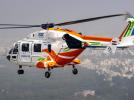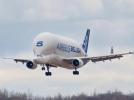Avianca F100 at Bogota on May 4th 2010, electrical and gear problem
The crew of an Avianca Fokker 100, registration HK-4488 performing flight AV-181 from Bogota (Colombia) to Guayaquil (Ecuador) with 91 passengers and 5 crew, reported gear trouble shortly after takeoff from Bogota and entered a holding to trouble shoot the problem. The airplane subsequently returned to Bogota for a safe landing on runway 13R about one hour after departure. 5 passengers needed medical attention due to anxiety attacks.
The Colombian CAA reported, that the airplane actually experienced an electrical problem resulting in the gear indication.
The NTSB reported on Sep 25th that the airplane endured a hard landing while landing in Bogota resulting in no injuries and minor damage to the aircraft. The Colombian CAA have requested assistance in decoding the flight data recorder from the NTSB laboraties.
In 2014 Colombia's Civil Aviation Authority (CCAA) released their final report in Spanish concluding the probable causes of the accident were:
Excessive vibration of the landing gear during rotation caused the torque damper link fixation pins to shear.
The CCAA reported the crew, the captain was pilot monitoring and the first officer pilot flying, was rotating for takeoff from Bogota's runway 13L when excessive vibrations were felt prompting the captain to take control of the aircraft. Climbing through 400 feet the commander ordered "gear up", however, the landing gear lever was locked into the extended position and the landing gear remained extended. A burning smell developed on the flight deck. The crew decided to immediately return to Bogota, however, working the checklists and detecting the anti-skid would not be available the crew decided to enter a hold to assess the situation with dispatch, maintenance and ATC.
The aircraft subsequently landed on runway 13R, after lowering the nose gear onto the runway the vibrations re-occurred, the crew operated the brakes and slowed the aircraft maintaining runway center line with the brakes, however, as the speed reduced the aircraft started to drift left about abeam taxiway T despite right rudder and right nose wheel steering input and the aircraft turning to the right. The aircraft came to a stop within the runway at a heading of about 180 degrees about 200 meters from taxiway D. 12 passengers required medical attention, however, there were no injuries. The aircraft sustained substantial damage to both its main landing gear struts, both main wheel assemblies were found rotated around the gear strut by about 90 degrees, the torque damper links and upper torque links were found broken on both main landing gear struts, brakes assembly lines were found damaged.
The runway had been contaminated with tyre rubber as well as hydraulic fluid and oil. The contamination was removed by emergency services.
The CCAA reported that after departure the crew received indication of the GND/FLT switch having failed as well as an anti-skid failure.
The CCAA reported that a hard landing inspection found no structural damage (except for main landing gear). Minor damage was found at a number of systems as result of the severe vibrations enduring during the takeoff rotation and the landing roll. A leak at the nose gear's shimmy damper was identified, the shimmy damper was removed.
The CCAA reported that the torque link dampers installed on both main landing gear struts had accumulated 10,939 cycles with a TBO of 12,000 cycles. The aircraft had undergone its last C-Check between November 20th 2009 and December 9th 2009, the last check of the Torque Damper Link oil levers was on Apr 15th 2010. The aircraft had encountered vibrations from the nose gear prompting the replacement of the nose wheels on Apr 24th 2010.
The CCAA analysed that the takeoff rotation commenced at 161 KIAS (187 knots over ground) to 165 KIAS (192 knots over ground), the tyre limiting speed was 195 knots, the takeoff thus remained within permitted limits, although it had been recommended by an operational bulletin to use different takeoff configurations at high altitude airports to achieve lower takeoff speeds. The operator had been authorized to use higher takeoff weights resulting in increased takeoff speeds. Without declaring emergency the crew returned to Bogota, received takeoff configuration alerts all the way to landing without possibility to silence the alarms, used flaps 42 for landing. After main gear touch down and subsequent nose gear touchdown the vibrations re-occurred, the crew maintained control until the aircraft had slowed and the aircraft began to drift left while turning clockwise at the same time. The aircraft came to a stop on the runway, was shut down and evacuated.
The CCAA analysed that the crew worked all relevant checklists and procedures related to the departure vibrations and locked gear handle fulfilling all requirements of standard operating procedures.
The CCAA analysed weather, ATC, aerodrome and communication were not factors into the occurrence.
The CCAA analysed that the vibrations encountered during the takeoff run came from the nose gear and re-occurred after the aircraft had touched down with the nose gear. The source of the vibration could not be established by the investigation. However, the nose wheel vibrations caused the fixation pins on the main gear to shear as result of an overload in the cross section with no prior fatigue cracks or damage.
Tracks on the runway (Photo: CCAA):
The main wheel positions after landing (Photo: CCAA):
http://avherald.com/h?article=42b17407














Komentarze